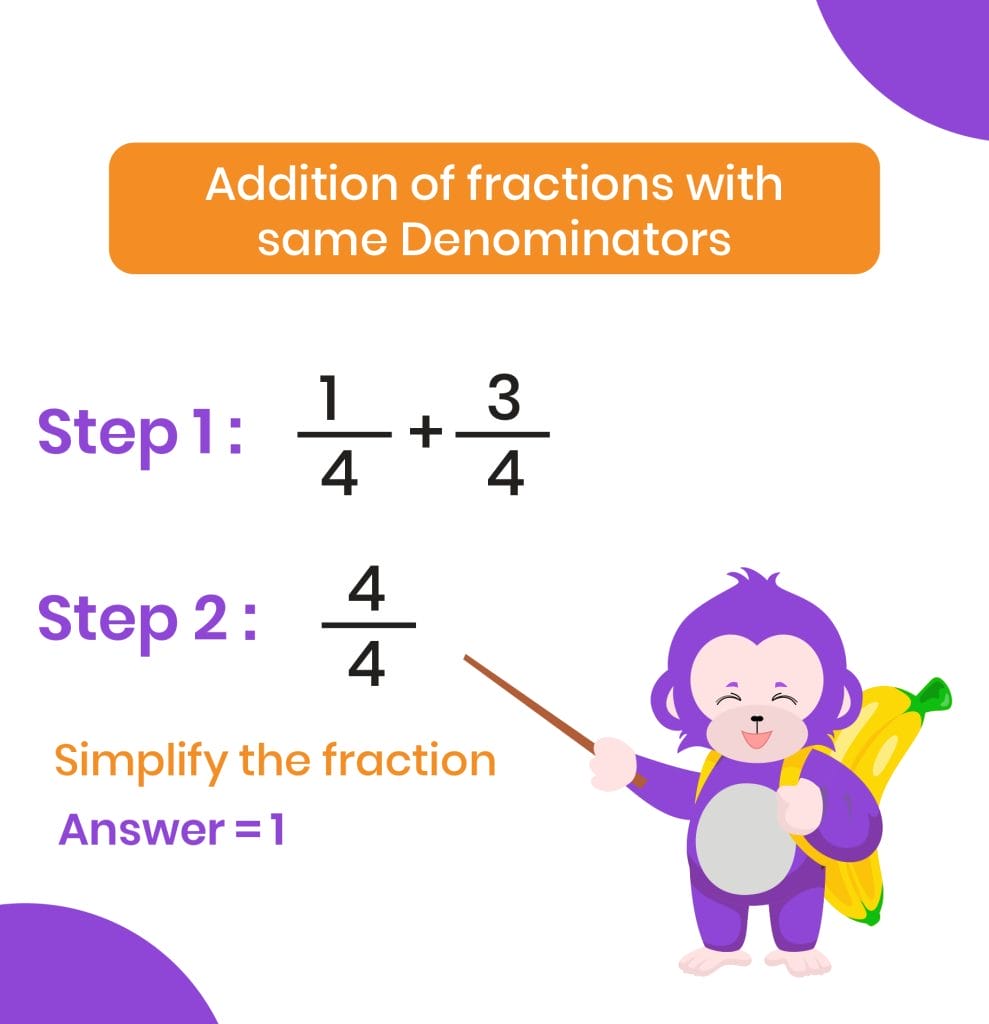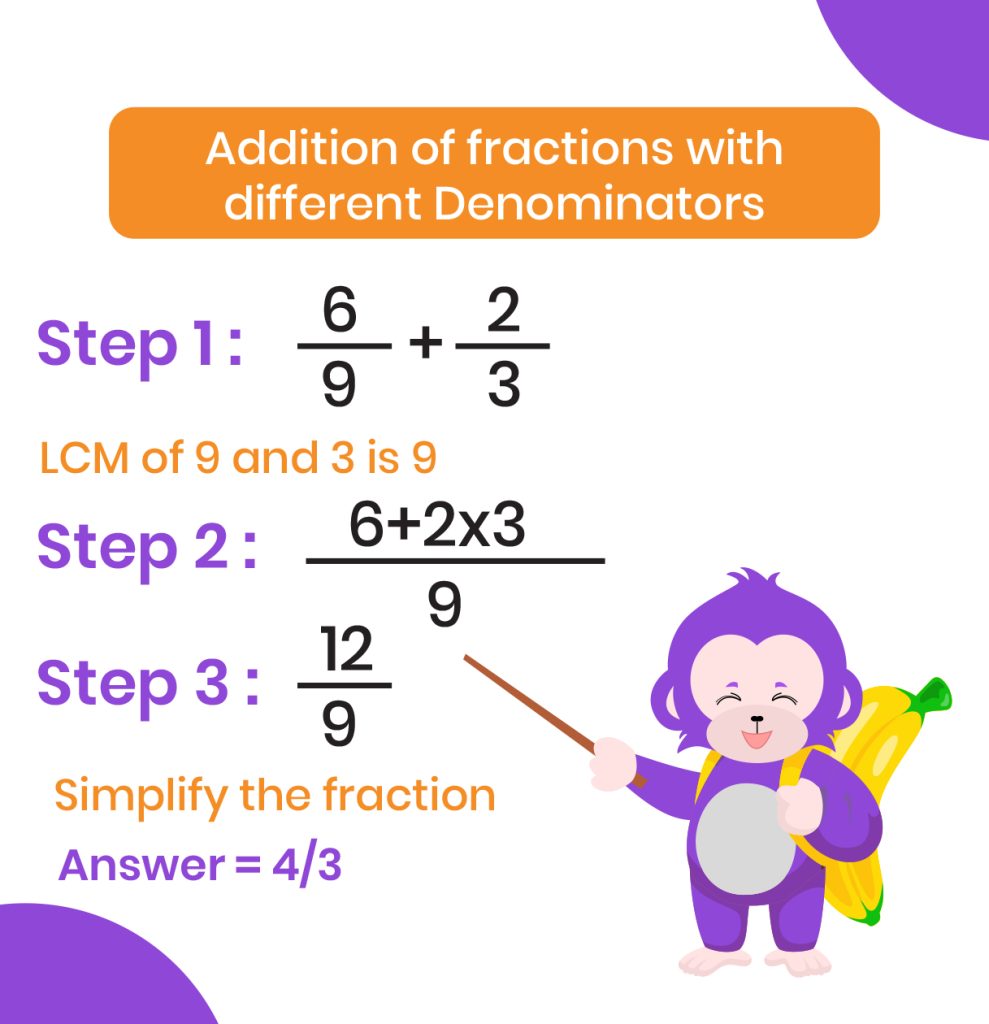How to add fractions? – Step-by-Step Guide
Table of Contents
Introduction
Understanding Fraction Addition
Adding fractions is a fundamental skill that is used in various mathematical operations. Whether it’s adding fractions with like denominators, unlike denominators, whole numbers, or mixed fractions, understanding the methods and techniques for fraction addition is crucial. In this comprehensive guide, we will explore the different scenarios of adding fractions and provide step-by-step explanations to master the art of fraction addition.
Analogy of Definition
The Basics of Adding Fractions
Adding fractions involves combining two or more fractional quantities to find their total sum. The key elements that play to add fractions are numerators, which represent the parts being added, and the denominators, which represent the total number of equal parts in the whole. In order to add fractions, it is essential to ensure that the denominators are either the same or made equivalent before performing the addition.
Method
Approaches to Adding Fractions
There are several methods with which we can add fractions, depending on the type of fractions being added. The methods include adding fractions with like denominators, adding fractions with unlike denominators, adding fractions with whole numbers, and adding mixed fractions. Each scenario requires a specific approach to ensure accurate and efficient addition.
Step-by-Step Guide
How to Add Fractions with Same Denominators?
When adding fractions with like denominators, simply add the numerators together while keeping the denominator unchanged.
For example, when adding 41 and 243 ,we get,
41 + 43 = 44 = 1

How to Add Fractions with Different Denominators?
When adding unlike fractions or fractions with different denominators, we first, make the denominators equivalent by finding the least common multiple (LCM) of the denominators. Then, we convert each fraction to an equivalent fraction with the common denominator and proceed to add the numerators.
Lets’s add 96 and 32
96 + 32
We can see that the fractions have different denominators, meaning they are unlike fractions.
Step 1: To solve the problem, we will first find the LCM of the denominators. The LCM of 3 and 9 = 9
Step 2: To convert the fractions into like fractions, we will have to multiply 32 with 33. 32 × 33 = 36
Step 3: Now that both the fractions are like, we will add them. 96 + 96 = 912
Step 4: As we can simply 912, our final answer will be 34

Adding Fractions with Whole Numbers
When adding fractions with whole numbers, convert the whole numbers to fractions with the denominator of 1. Then, proceed to make the denominators same and add the fraction.
For example: Let’s add 34 with 3
Step 1: We will first write 3 in a fraction form with 1 as the denominator as 13
Step 2: We will then multiply 13 with 3, to get the same denominator. We will get 13 × 33 = 39
Step 3: Now, adding 34 with 39 , we get 34 + 39 = 313
Adding Mixed Fractions
To add mixed fractions, first, convert the mixed fractions to improper fractions. Then, proceed to add the fractions as usual, ensuring that the final sum is simplified to its simplest form if necessary.
Lets add, 141 + 231
Step 1: First, we will convert the mixed fraction into improper fraction as 44∗1+1 + 43∗2+1 = 45 +37
Step 2: We will then add the converted fraction 125∗3 + 127∗4 = 1215+1228 = 1243
Learn more about fractions on our site, visit ChimpVine.
Examples
Practical Scenarios to Add Fractions
Let’s explore some practical examples of adding fractions in different scenarios.
Example 1: Add Fractions with Like Denominators
1/3 + 2/3 = 3/3 = 1
Example 2: Adding with Unlike Denominators
1/4 + 1/6 = 3/12 + 2/12 = 5/12
Example 3: Adding Fractions with Whole Numbers
2 + 1/5 = 10/5 + 1/5 = 11/5
Example 4: Adding Mixed Fractions
131 + 241 = 34 + 49 = 1216 + 1227 = 1243
Quiz
Tips and Tricks
1. Adding Fractions with Like Denominators
Tip: When adding fractions with like denominators, simply add the numerators together while keeping the denominator unchanged.
Calculation: 3/4 + 9/4 = 12/4 = 3
2. Adding Fractions with Unlike Denominators
Tip: To add fractions with unlike denominators, find the least common multiple (LCM) of the denominators and convert the fractions to equivalent fractions with the common denominator.
Calculation: 1/3 + 1/5 = 5/15 + 3/15 = 8/15
3. Adding Fractions with Whole Numbers
Tip: We can add whole number and fraction by expressing it as a mixed fraction and then converting it into improper fraction.
Calculation: 2 + 41 =241= 44∗2+1 = 49
Real life application
Story: “The Fraction Feast”
In a delightful feast, friends gathered to share their favorite dishes, each bringing a unique fraction of the meal. As they combined their culinary creations, they encountered various scenarios of adding fractions in real-life situations.
Scenario 1: The Pizza Party
As the friends enjoyed a pizza party, they realized that by adding 3/4 of a pizza with 1/4 of another pizza, they had a total of 1 whole pizza to share.
Scenario 2: The Baking Bonanza
During a baking bonanza, the chefs discovered that by adding 1/2 cup of flour to 1/3 cup of sugar, they had a total of 5/6 cup of dry ingredients for their recipe.
Scenario 3: The Grocery Gathering
At the grocery store, the friends gathered 221 of apples and 3/4 pounds of bananas, resulting in a total of 13/4 pounds of fruit for their culinary creations.
Scenario 4: The Dessert Delight
In a delightful dessert adventure, the bakers combined 121 of flour with 3/4 cup of sugar, resulting in a total of 9/4 cups of dry ingredients for their delectable treats.
Scenario 5: The Pie Pleasure
During a pie feast, the friends savored 1/3 of a pie and 1/6 of another pie, resulting in a total of 1/2 pies consumed during their delightful gathering.
FAQ's
Like? Share it with your friends






